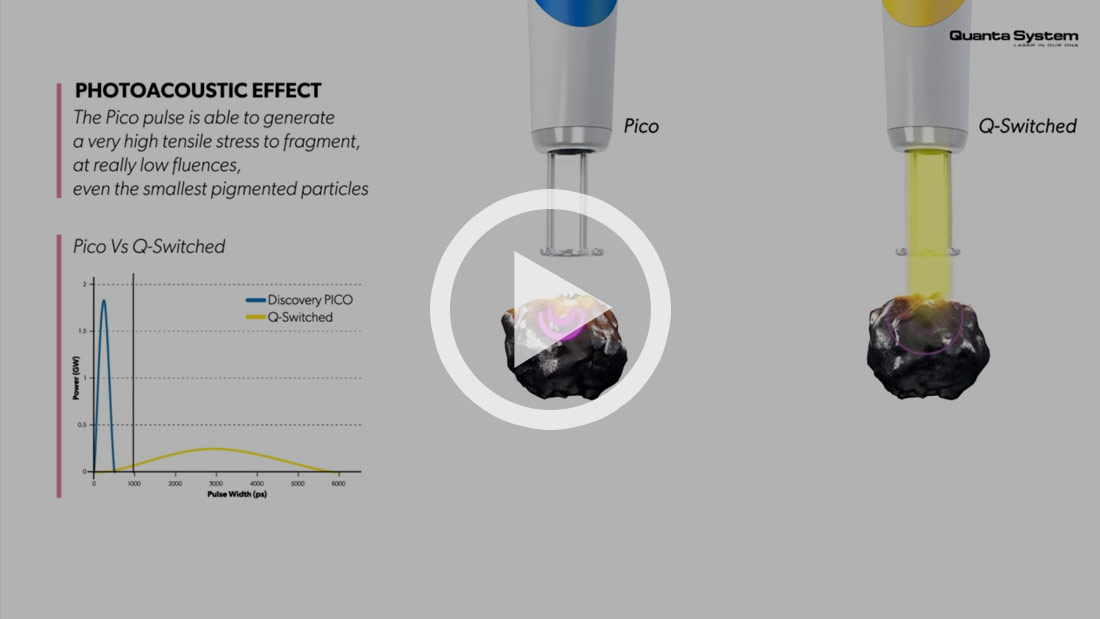Pico Lasers
These lasers can be split into 2 camps – High-Quality Pico & Low-Quality Pico.
A High-Quality Pico utilises a seed laser to interfere with an actively Q switched treatment beam. Light is used to control light delivering a fixed pulse width or shutter speed (in our laser 350ps KTP or 450ps Nd Yag) at a high energy of 800mj.
A Low-Quality Pico utilises older repackaged Q switched technology and runs the Q switch faster – electronics controls light producing an unstable fluctuating pulse width or shutter speed that cannot be faster than 500ps and becomes longer as the fluence increases. The max energy output is only 400mj.
Half the energy at a wider pulse width equals low power, slow results and disappointing clinical outcomes.
Most of the clinical trials that compare Tattoo Removal in Pico vs Q switched lasers carry a medium to high level of bias (bias is any departure of results from the truth). The evidence that Pico lasers can outperform Q switched lasers for even black tattoos is relatively sparse. Mutlicoloured tattoos certainly require multiple wavelengths for optimal results.
However, the following is true:
Q switched lasers are more Photo-Thermal (generate more heat) than Pico Lasers which are more Photo-Mechanical. Hence, Pico has an advantage in darker skin types with less risk of colour change (Hyperpigmentation or Hypopigmentation) and probably less risk of scarring (note that our active Q switched lasers only carry a scarring risk of < 0.5%).
In our experience, High Quality Pico technology will probably reduce the number of treatment sessions by about 25% for black tattoos. This technology was initially advertised as being capable of delivering tattoo removal 4 times more quickly than the most advanced Q switched lasers. This claim is no longer made by any manufactures. Pico technology is certainly not the tattoo removal game changer we all hoped for.
Most Pico lasers are single cavity platforms with one primary laser. They struggle with multi-coloured tattoos and some manufacturers cheat by adding energy sapping dye handpieces to try and overcome this problem. Multi-coloured Tattoos require high power multiple wavelengths for effective removal (both these points are discussed in detail below).
Pico lasers do have huge advantages over Q switched technology for the treatment of pigmented lesions in darker skin types ( Fitz IV -VI) as they considerably reduce the risk of unwanted side effects such as PIH. This was our clinic’s major motivator for purchasing Pico technology.
Active Q Switching
Our active Q switched lasers have the ability to deliver a single high-energy pulse. This is important because only the 1st pulse is able to shatter the tattoo pigment, leaving water vapour behind forming a frosted white appearance.

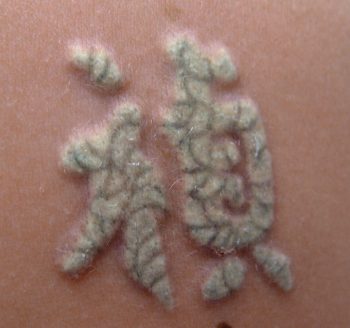
This frosted white reaction forms an impenetrable optical shield. If additional pulses are stacked in the same area they will only have the unwanted effect of over heating the skin resulting in thermal damage.
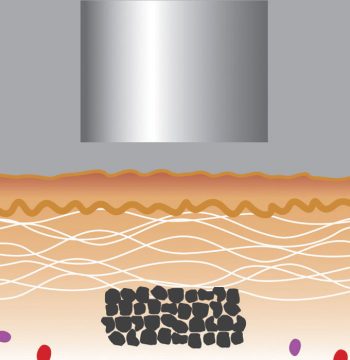
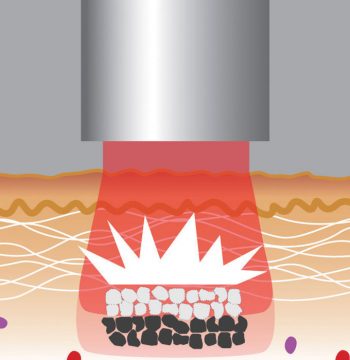
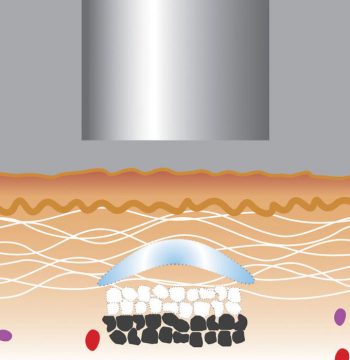
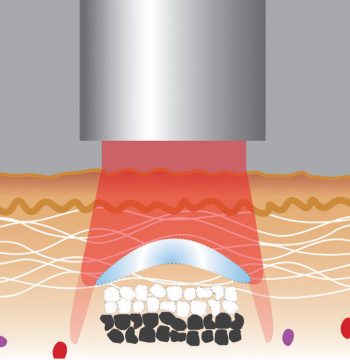
We are able to deliver a square homogenous dose of laser light without any hot spots ensuring energy is evenly distributed over the tattoo. The square beam profile enables very accurate coverage of the tattoo without any unwanted overlap of pulses. Any excess heat is removed by skin cooling using forced cold air.
Passive Q Switching
Most of the technologies advertised for the removal of tattoos are cheaper lasers that produce a train of smaller pulses of energy, delivered rapidly (like a machine gun) and misleadingly added together to give one energy output. It is inferior and much cheaper to produce than an active Q switched laser.
Active Q switching is like effectively using a large hammer to hit a stone with a single hard blow.
Passive Q switching is like ineffectively using a small hammer to lightly tap the stone repeatedly.
Spot Size
Our advanced high-powered lasers enable larger spot sizes up to 8mm. The larger the spot size the deeper the energy can be placed.
High single pulse energy and large spot sizes enable much deeper laser penetration depths. The result is effective treatment of deep lying tattoo pigment.

Due to higher single pulse energies, larger spotsizes with larger penetration depths can be used thereby enabling treatments of deeper-lying targets.
Cheaper lasers typically have a 1mm spot size and hence treatment is limited to superficial targets.
Pulse Width
Maximal temperatures reached inside a treated tattoo particle are estimated to be over 900 degrees centigrade. Skin only has the ability to tolerate these incredible temperatures for a very short duration, hence our lasers use extremely short pulse widths (shutter speeds) typically from 370 trillionths up to 30 billionths of a second. Short pulse widths ensure heat damage to the skin is minimal.
Additional skin protection is provided with refrigerated cold air directed over the skin during treatment to ensure any unwanted heat transferred to the skin is effectively removed.
Wavelength
No single laser can remove all types of tattoo ink and hence multiple laser wavelengths are required to optimally remove a professional multi-coloured tattoo.
These tattoos contain a variety of inks and dyes with each colour often made of a range of individual pigments. At least 60 trade colours from 18 chemical compounds exist. Colours that appear visually similar will often respond differently to laser depending on the pigment mix. This is further complicated by the fact that many older tattoos contain heavy metal salts leading to variable or inconsistent responses.
As different inks and different colours react in diverse ways to laser light best results are achieved with as many colours of laser light as possible.
The best absorption of a particular laser colour (wavelength) is achieved in its complementary colour.

At our Cambridge Laser Clinic, the following colours of laser light are available:
- Nd Yag 1064nm (Invisible Infrared) for the removal of black, dark blue, white, grey and brown ink
- Ruby 694nm (Deep Red Light) for the treatment of black, blue and green ink
- KTP 532nm (Green Light) for the treatment of red, dark blue, orange and purple ink
Dye Handpieces
None of our tattoo removal lasers utilise inefficient energy sapping dye handpieces.
Multiple laser platforms are now available claiming to treat all colours of tattoo ink. Unfortunately these lasers have a single primary laser and numerous attachments that alter this wavelength to a different colour. Each time the beam passes through the dye handpiece, the energy output usually drops by 50%. Often the beam is passed through 2 separate dye handpieces to achieve a certain colour of laser light hence the resultant energy output is only 25% of the primary laser.
This is a cheap method of claiming you possess all the necessary laser light colours to remove multi-coloured tattoos. Unfortunately due to low power outputs, results will be disappointing.
Fractional Pico & Q switched lasers
This is the latest advance in Pico & Q switched laser technology. Fractional lasers only treat part of the skin leaving uninjured skin around the treatment site. Our lasers have the ability to split the laser beam into a matrix of 70 microscopic laser beams each 200um in diameter to drill into the tattoo. Only 10% of the surface is exposed to the laser on each pass leaving much of the surrounding skin undisturbed. These micro-beams are able to penetrate much deeper into the skin than the standard beam, producing micro-bleeding by fenestration of capillaries. Platelet release and the stimulation of wound healing response enables fractionated treatments to deliver the following:
- An acceleration of recovery times in the early stages of tattoo removal
- An effective treatment of stubborn recalcitrant inks
- Clinical improvement in cases of ‘white ghosting’ or unwanted scarring following laser treatment.
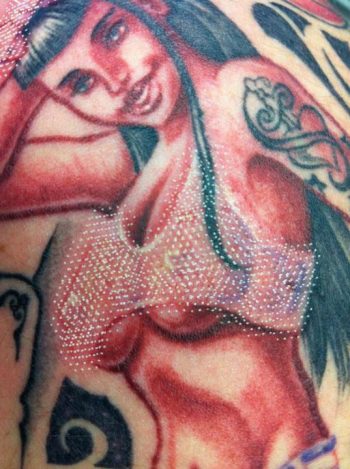
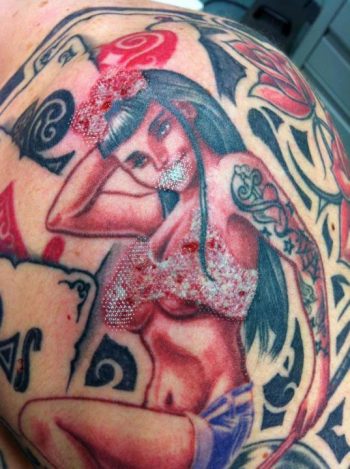
Within the same session we will often perform several passes in a fractionated mode prior to a traditional Q switched treatment.
Our expert medical team has in excess of 30 years laser experience and have completed more than 150,000 successful treatments. Rest assured you are in safe hands. All procedures at our Cambridge Laser Clinic are performed by fully qualified doctors, nurses and practitioners.
To ensure the highest ethical standards are maintained at all times, our staff are never offered bonus incentives to sell treatments.
Although medical laser clinics are no longer regulated by the CQC (Care Quality Commission), we continue to adhere to the strict standards that were in the past mandatory under government legislation. This is the best indicator currently available that our Cambridge Laser Clinic is trustworthy.
All consultations are free of charge so why not call our team of experts today?
If you would like to book a FREE consultation, give us a call.

